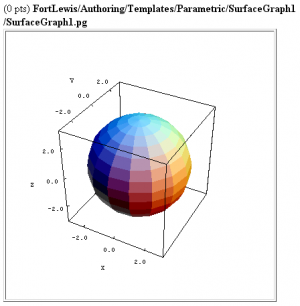SurfaceGraph1
Graphing a Parametric Surface in 3D
This PG code shows how to make an interactive graph of a parametric surface that is displayed using the LiveGraphics3D Java applet.
- Download file: File:SurfaceGraph1.txt (change the file extension from txt to pg when you save it)
- File location in NPL:
FortLewis/Authoring/Templates/Parametric/SurfaceGraph1/SurfaceGraph1.pg
| PG problem file | Explanation |
|---|---|
|
Problem tagging: |
|
DOCUMENT(); loadMacros( "PGstandard.pl", "MathObjects.pl", "LiveGraphicsParametricSurface3D.pl", ); TEXT(beginproblem()); |
Initialization:
We need to include the macros file |
Context("Numeric");
Context()->variables->are(x=>"Real",y=>"Real",z=>"Real",u=>"Real",v=>"Real");
$plot = ParametricSurface3D(
Fx => Formula("3*cos(u)*sin(v)"),
Fy => Formula("3*sin(u)*sin(v)"),
Fz => Formula("3*cos(v)"),
uvar => 'u', # theta
vvar => 'v', # phi
umin => 0,
umax => 2*pi,
vmin => 0,
vmax => pi,
usamples => 15,
vsamples => 15,
axesframed => 1,
xaxislabel => "X",
yaxislabel => "Y",
zaxislabel => "Z",
mesh => 0,
outputtype => 4,
);
|
Setup: |
Context()->texStrings;
BEGIN_TEXT
\{
Live3Ddata(
$plot,
image => "sphere.png",
size => [400,400],
tex_size => 600,
tex_center => 1,
scale => 1.1,
);
\}
END_TEXT
Context()->normalStrings;
|
Main Text:
We generate a string of plot data using
Setting |
$showPartialCorrectAnswers = 1; |
Answer Evaluation: |
Context()->texStrings;
BEGIN_SOLUTION
${PAR}SOLUTION:${PAR}
Solution explanation goes here.
END_SOLUTION
Context()->normalStrings;
COMMENT('MathObject version.');
ENDDOCUMENT();
|
Solution: |
